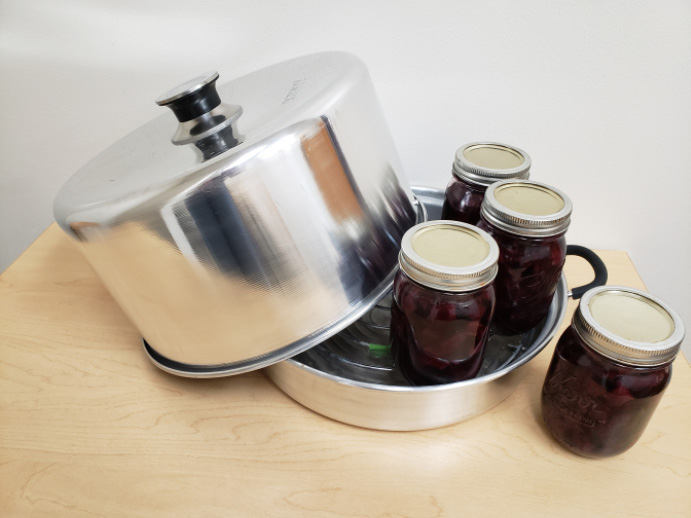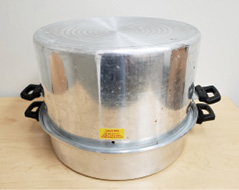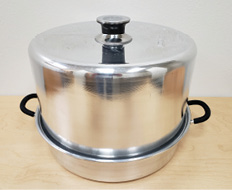What is a steam canner?
An atmospheric steam canner, usually referred to as a steam canner, has a shallow base with a rack where jars sit above boiling water, and a tall domed top with vent holes on either side near the base. Water boiling in the base creates steam that surrounds jars during processing, so we refer to these canners as steam canners.
Why use a steam canner?
A steam canner may be used to safely can acidic foods such as pickles, salsa, jams, jellies, and fruits. Use recipes that have been tested as safe for a boiling water canner from the National Center for Home Food Preservation or from your state Extension program. Unlike a boiling water canner that may require the user to heat 16 or more quarts of water, a steam canner uses only about 2 quarts of water, shortening the time to bring the canner to temperature. Once the canner is fully steaming, the processing time for a steam canner is the same as a boiling water canner. Do not use a steam canner to process low-acid foods such as meat or vegetables. Low-acid foods must be processed in a pressure canner.
Using a steam canner
Follow these steps to use a steam canner to safely preserve food.
- Choose a safe canning recipe. Use an up-to-date research-tested recipe for safe canning of acidic foods, those foods with a pH of 4.6 or below such as fruits, salsa, pickles, jams, and jellies. Note: Do not assume that recipes provided with the canner are research-tested and safe. Instead, refer to trusted sources of safe canning recipes.
- Prepare jars and food according to tested recipe instructions. Make sure jars have been washed in soapy water just before use, and warm them prior to filling. Follow recipe directions for how to prepare and heat food before you apply a two-piece lid.
- Ready the steam canner. Fill the base of the canner with water to the level of the rack, and place the canner on the stove, cover and turn on the surface unit to heat. Preheat the water in the base to just below boiling.
- Place filled jars in the canner on the rack inside as they are filled. Most steam canners will hold 10 half-pints, 8 pints, or 7 quarts. Arrange jars so that steam can freely circulate around the jars. After the canner is filled or you run out of jars, place the lid on the canner. Prepare only as many jars as will fit in a canner in one load, keeping jars warm and food hot.
- Process jars, adjusting time based on elevation. Increase stove-top temperature to high and wait for steam to vent from the holes on either side of the canner lid, near the base.* Vent to purge air from the canner, allowing a column of steam (6 to 8 inches of steam) to vent for one full minute before you start timing the canning process. Once venting is complete, start timing the process, adjusting for elevation as needed. It may take 3 to 10 minutes for a full canner to reach temperature and vent for one complete minute. Once the processing time is started, you may reduce heat under the canner to maintain a steady column of steam from the vent ports. Be sure to adjust processing time for elevation. Add process time for elevations 1,000 feet above sea level as directed in a research-tested recipe. Check elevation at https://www.advancedconverter.com/map-tools/find-elevation-of-address.
- Process time must be limited to 45 minutes or less, including any modification for elevation. The processing time is limited by the amount of water in the canner base. When processing food, the canner should not be opened to add water. Regulate heat so that the canner continues to steam but not boil too vigorously. A canner that is boiling too vigorously can boil dry within 20 minutes. If a canner boils dry, the food is considered under-processed and potentially unsafe.
- You may mix jar sizes during canning, but do not open the lid during the timed process. For example, if processing a mix of half-pints and pint jars where the processing time is 10 minutes for half-pints and 15 minutes for pints, process all jars for 15 minutes.
- Do not stack jars in an atmospheric steam canner. The risk of jar breakage is too great. Remove and cool jars. When the processing time is done, turn off the timer. If desired, wait five minutes before carefully removing the domed lid. Use caution as steam will pour from the canner and the jars will be HOT. Transfer jars to a rack or towel for cooling. Protect jars from drafts while they cool. Once cooled, check seals. See information on cooling jars and testing jar seals
- Remove and cool jars. When the processing time is done, turn off the timer. If desired, wait five minutes before carefully removing the domed lid. Use caution as steam will pour from the canner and the jars will be HOT. Transfer jars to a rack or towel for cooling. Protect jars from drafts while they cool. Once cooled, check seals. See information on cooling jars and testing jar seals.
*Steam will circulate best if there is a vent hole on either side of the domed lid. A second hole may be drilled in the lid, if necessary.
Back-to-Basics steam canner
Victorio (VKP) steam canner
How do I safely store home canned food?
After processing, allow lids to seal naturally and let jars cool, undisturbed. Remove ring bands and wash the lid and jar with warm, soapy water to remove food residue, rinse and dry. Wash ring bands by hand to protect them from corrosion, then dry and set aside for future use. Store jars without ring bands to make it easier to detect if jars become unsealed. Label jars and store in a cool room, protected from sunlight. For best quality, use within a year.
Researchers affiliated with the National Center for Home Food Preservation tested the Back-to-Basics and the Victorio (VKP) dome-lid style steam canners and found them safe for canning acidic foods when a tested recipe was followed. Other styles of steam canners were not tested. Be sure to check with the manufacturer for instructions on safely using other styles of steam canners.
Reference
P. Willmore, M. Etzel, E. Andress, and B. Ingham. 2015. Home Processing of Acid Foods in Atmospheric Steam and Boiling Water Canners. Food Protection Trends. 35:150-160.
Check with your local Extension program for more information and for safe food preservation tips and recipes.
By Barbara Ingham, Professor, University of Wisconsin-Madison; Julie Garden-Robinson, Food and Nutrition Specialist/Professor – NDSU Extension; Marlene Geiger, Consumer Specialist, Iowa State University; Karen Blakeslee, Extension Associate, Kansas State University; Rebecca West, Program Assistant, NDSU Extension; and Carol Larvick, Extension Educator, University of Nebraska.
Funding for this publication was made possible by the U.S. Department of Agriculture’s Agricultural Marketing Service through grant 21SCBPND1069. Its contents are solely the responsibility of the authors and do not necessarily represent the official views of the USDA.
Information in this publication is provided purely for educational purposes. No responsibility is assumed for any problems associated with the use of products or services mentioned. No endorsement of products or companies is intended, nor is criticism of unnamed products or companies implied.
NDSU encourages you to use and share this content, but please do so under the conditions of our Creative Commons license. You may copy, distribute, transmit and adapt this work as long as you give full attribution, don’t use the work for commercial purposes and share your resulting work similarly. For more information, visit www.ag.ndsu.edu/agcomm/creative-commons.
County commissions, North Dakota State University and U.S. Department of Agriculture cooperating. NDSU does not discriminate in its programs and activities on the basis of age, color, gender expression/identity, genetic information, marital status, national origin, participation in lawful off-campus activity, physical or mental disability, pregnancy, public assistance status, race, religion, sex, sexual orientation, spousal relationship to current employee, or veteran status, as applicable. Direct inquiries to Vice Provost for Title IX/ADA Coordinator, Old Main 201, NDSU Main Campus, 701-231-7708, ndsu.eoaa@ndsu.edu. This publication will be made available in alternative formats for people with disabilities upon request, 701-231-7881. web-10-22





